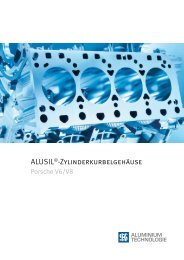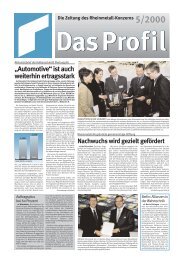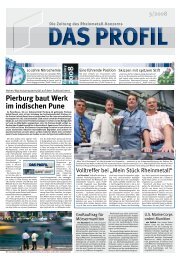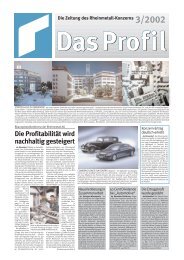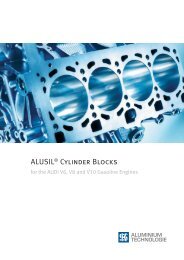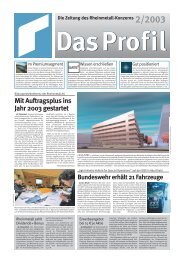Annual Report 2001 - KSPG AG
Annual Report 2001 - KSPG AG
Annual Report 2001 - KSPG AG
Create successful ePaper yourself
Turn your PDF publications into a flip-book with our unique Google optimized e-Paper software.
104<br />
Consolidated financial statements <strong>2001</strong> of Kolbenschmidt Pierburg <strong>AG</strong><br />
Notes<br />
Comments on the segment reports Supplementary disclosures<br />
(34) Segment reports In accordance with the Kolbenschmidt<br />
Pierburg Group’s internal controlling<br />
organization, the Group breaks down<br />
into six divisions, viz.<br />
– Air Supply & Pumps<br />
– Pistons<br />
– Plain Bearings<br />
– Aluminum Technology<br />
– MotorEngineering<br />
– Motor Service<br />
as primary segments.<br />
The “Others/consolidation” column<br />
includes, apart from the Group’s<br />
parent (Kolbenschmidt Pierburg <strong>AG</strong>),<br />
further companies not allocable to any<br />
defined segment, as well as<br />
consolidation transactions.<br />
With economic effect as of December<br />
31, <strong>2001</strong>, the MotorEngineering division<br />
was deconsolidated, which is<br />
why no balance sheet data is reported<br />
for <strong>2001</strong> for this segment.<br />
Responsibilities are clearly separated<br />
between the segments and Kolbenschmidt<br />
Pierburg <strong>AG</strong>, which performs<br />
the functions of a strategic management<br />
holding company. Both corporate<br />
governance and internal reporting<br />
have been structured accordingly.<br />
The companies belonging in each<br />
segment/division result from the list<br />
headed “Group of consolidated companies”<br />
on pages 110 and 111. In line<br />
with the Kolbenschmidt Pierburg<br />
Group’s shareholder value concept,<br />
segment assets and liabilities include<br />
the essential assets (excluding cash<br />
& cash equivalents) and liabilities (excluding<br />
pension accruals and financial<br />
debts). Capital employed (CE), which<br />
is used to generate EBIT, is deter-<br />
mined as the difference between<br />
segment assets and liabilities. The<br />
return on capital employed (ROCE)<br />
equals EBIT divided into average<br />
capital employed (average of the<br />
balances at December 31, 2000 and<br />
<strong>2001</strong>). Net financial debts reflect the<br />
sum total of financial debts (current<br />
and noncurrent) less cash & cash<br />
equivalents.<br />
The intersegment transfers principally<br />
indicate sales among divisions and<br />
are priced as if at arm’s length.<br />
EBITDA means earnings before interest,<br />
taxes, depreciation and amortization.<br />
Write-up of badwill has consistently<br />
been included in EBITDA. The EBIT<br />
margin equals EBIT divided into total<br />
segment sales.<br />
Capital expenditures and amortization/depreciation<br />
refer to tangible<br />
and intangible assets (including<br />
goodwill).<br />
(35) Contingent liabilities<br />
Contingent liabilities under bonds and<br />
guaranties total €2.6 million (up from<br />
€1.9 million), while none exist to joint<br />
venture creditors.<br />
Due to its hardly probable utilization,<br />
the provision for several accrued liabilities<br />
with a potential impact on<br />
future net incomes of €0.9 million<br />
(up from €0 million) had to be waived.<br />
(36) Other financial obligations As of December 31, <strong>2001</strong>, the commitments<br />
to purchase tangible and intangible<br />
assets totaled €36.6 million (up<br />
from €31.4 million).<br />
(37) Subsequent events After closing the fiscal year, Kolbenschmidt<br />
Pierburg <strong>AG</strong>’s Executive Board<br />
decided to shut down part of the<br />
Ft. Wayne, Indiana, plant at the turn<br />
of 2002/03 in order for the US Pistons<br />
subsidiaries to return to sustained<br />
profitability as early as possible.<br />
(38) Stock appreciation rights<br />
(SARs)<br />
Since 1999, the Kolbenschmidt Pierburg<br />
Group has granted qualifying<br />
managerial staff SARs for them to<br />
participate in any stock appreciation.<br />
SAR programs are basically phantom<br />
stock option plans under which participants<br />
receive a cash compensation<br />
upon exercise that equals the difference<br />
between the stock price at exercise<br />
date and the base (reference)<br />
price. There are two different programs.<br />
For managerial staff, this base price<br />
has been fixed at the arithmetic mean<br />
of the closing prices quoted on the 10<br />
market days preceding plan commencement;<br />
for executive board members,<br />
the base price is determined at<br />
50 percent from the arithmetic mean<br />
of the closing prices of Kolbenschmidt<br />
Pierburg common stock and, at 25<br />
percent each, from the arithmetic<br />
Refunds of €0.3 million (up from €0<br />
million) are expected for contingent<br />
liabilities.<br />
One consequence is that this plant at<br />
Ft. Wayne will be reformatted for its<br />
use as mass production location only,<br />
the idled machines being largely employed<br />
elsewhere by other companies<br />
of the Group.<br />
mean of Rheinmetall preferred and<br />
common stock. Either SAR program<br />
has an overall term of 7 years: after<br />
a 3-year qualifying period, SARs may<br />
be exercised during defined time windows<br />
during the residual 4-year term.<br />
If not exercised during such period or<br />
when eligible staff leave Kolbenschmidt<br />
Pierburg for any reason other than retirement<br />
or death, the SARs become<br />
forfeited and lapse. SARs cannot be<br />
exercised unless and until the base<br />
price has been exceeded by 25 percent<br />
or more on the day of exercise.<br />
105


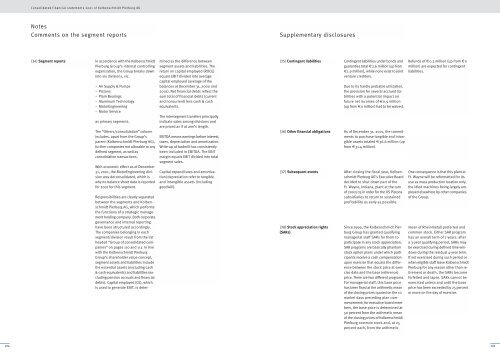
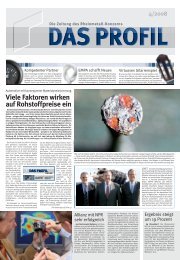
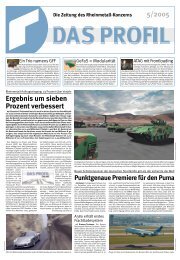
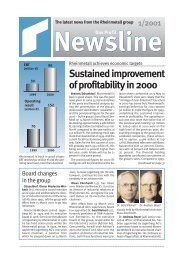
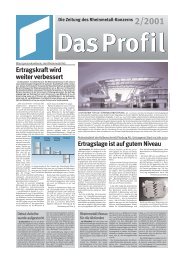
![PDF [1.0 MB] - KSPG AG](https://img.yumpu.com/5513074/1/171x260/pdf-10-mb-kspg-ag.jpg?quality=85)
